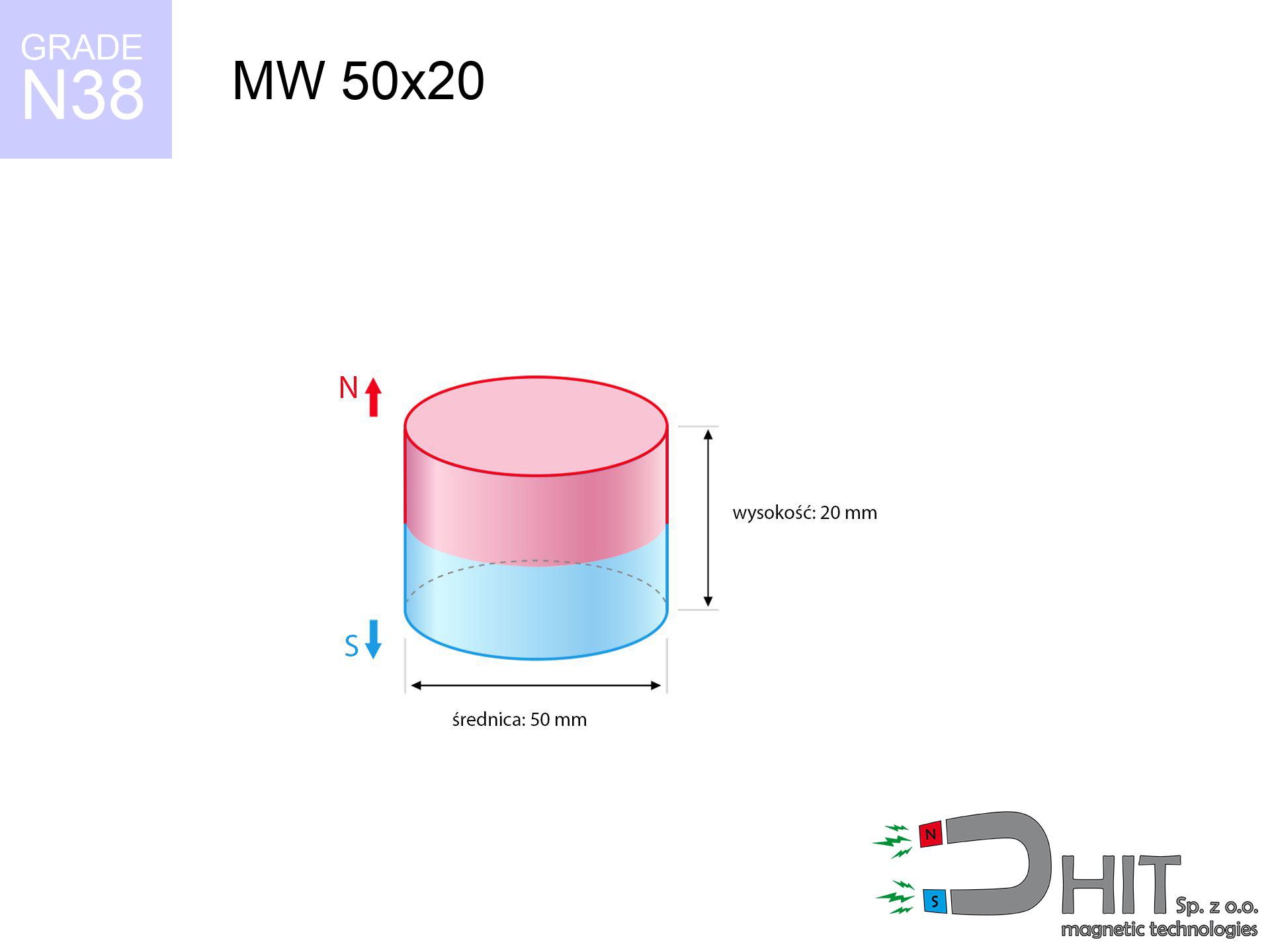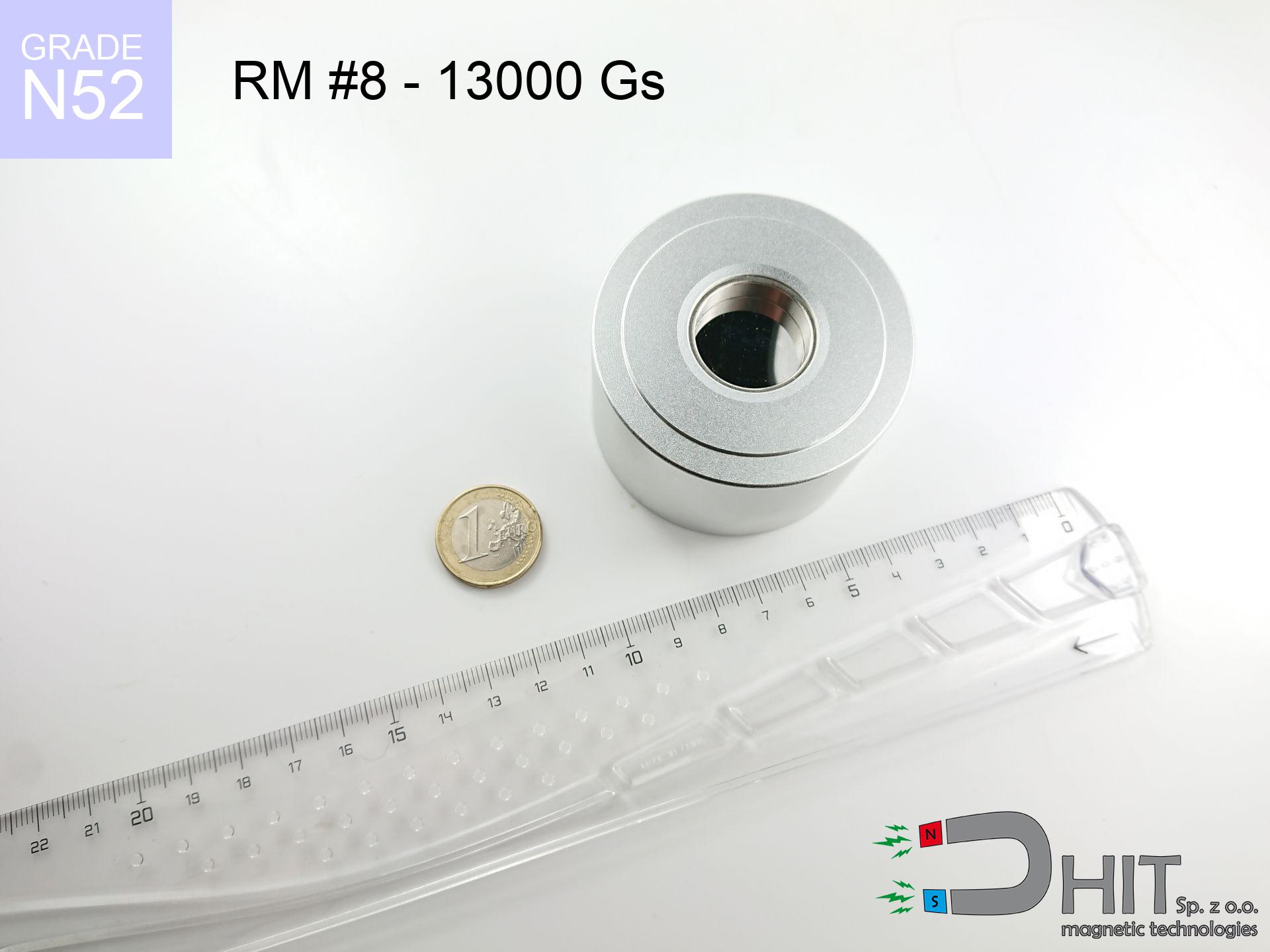MW 50x20 / N38 - cylindrical magnet
cylindrical magnet
Catalog no 010080
GTIN: 5906301810797
Diameter Ø
50 mm [±0,1 mm]
Height
20 mm [±0,1 mm]
Weight
294.52 g
Magnetization Direction
↑ axial
Load capacity
55.29 kg / 542.21 N
Magnetic Induction
387.23 mT
Coating
[NiCuNi] nickel
106.96 ZŁ with VAT / pcs + price for transport
86.96 ZŁ net + 23% VAT / pcs
bulk discounts:
Need more?Hunting for a discount?
Contact us by phone
+48 22 499 98 98
or contact us via
request form
our website.
Specifications and appearance of magnetic components can be reviewed on our
power calculator.
Same-day processing for orders placed before 14:00.
Magnetic properties of material N38
Physical properties of sintered neodymium magnets Nd2Fe14B at 20°C
Shopping tips
Strengths and weaknesses of rare earth magnets.
Besides their remarkable pulling force, neodymium magnets offer the following advantages:
- They retain attractive force for around 10 years – the loss is just ~1% (in theory),
- Neodymium magnets are characterized by highly resistant to loss of magnetic properties caused by magnetic disturbances,
- In other words, due to the metallic finish of silver, the element gains visual value,
- Neodymium magnets generate maximum magnetic induction on a small surface, which increases force concentration,
- Neodymium magnets are characterized by very high magnetic induction on the magnet surface and can function (depending on the shape) even at a temperature of 230°C or more...
- Thanks to versatility in constructing and the capacity to adapt to client solutions,
- Versatile presence in future technologies – they find application in magnetic memories, electric motors, medical devices, also technologically advanced constructions.
- Compactness – despite small sizes they provide effective action, making them ideal for precision applications
Disadvantages of NdFeB magnets:
- At strong impacts they can crack, therefore we advise placing them in strong housings. A metal housing provides additional protection against damage and increases the magnet's durability.
- Neodymium magnets lose their power under the influence of heating. As soon as 80°C is exceeded, many of them start losing their power. Therefore, we recommend our special magnets marked [AH], which maintain durability even at temperatures up to 230°C
- Magnets exposed to a humid environment can corrode. Therefore when using outdoors, we suggest using waterproof magnets made of rubber, plastic or other material protecting against moisture
- Limited possibility of producing nuts in the magnet and complex shapes - preferred is casing - magnetic holder.
- Health risk resulting from small fragments of magnets can be dangerous, in case of ingestion, which becomes key in the aspect of protecting the youngest. Additionally, small elements of these magnets can disrupt the diagnostic process medical in case of swallowing.
- Due to expensive raw materials, their price exceeds standard values,
Maximum lifting capacity of the magnet – what contributes to it?
Breakaway force was determined for ideal contact conditions, assuming:
- with the application of a yoke made of special test steel, ensuring full magnetic saturation
- whose thickness is min. 10 mm
- with a plane free of scratches
- without the slightest clearance between the magnet and steel
- under vertical force direction (90-degree angle)
- at temperature approx. 20 degrees Celsius
Practical aspects of lifting capacity – factors
During everyday use, the real power is determined by several key aspects, presented from crucial:
- Distance – existence of foreign body (rust, tape, gap) acts as an insulator, which lowers capacity rapidly (even by 50% at 0.5 mm).
- Loading method – catalog parameter refers to detachment vertically. When attempting to slide, the magnet exhibits significantly lower power (often approx. 20-30% of nominal force).
- Substrate thickness – to utilize 100% power, the steel must be sufficiently thick. Paper-thin metal restricts the attraction force (the magnet "punches through" it).
- Metal type – different alloys reacts the same. Alloy additives weaken the interaction with the magnet.
- Base smoothness – the smoother and more polished the surface, the better the adhesion and stronger the hold. Roughness acts like micro-gaps.
- Temperature – heating the magnet results in weakening of induction. It is worth remembering the maximum operating temperature for a given model.
* Holding force was checked on a smooth steel plate of 20 mm thickness, when a perpendicular force was applied, however under shearing force the holding force is lower. Moreover, even a small distance {between} the magnet’s surface and the plate decreases the lifting capacity.
Safety rules for work with NdFeB magnets
Keep away from computers
Very strong magnetic fields can corrupt files on payment cards, hard drives, and storage devices. Stay away of min. 10 cm.
Magnets are brittle
NdFeB magnets are sintered ceramics, meaning they are very brittle. Clashing of two magnets leads to them breaking into small pieces.
Compass and GPS
A powerful magnetic field disrupts the functioning of magnetometers in smartphones and navigation systems. Maintain magnets near a device to avoid breaking the sensors.
Sensitization to coating
Certain individuals experience a sensitization to Ni, which is the common plating for neodymium magnets. Frequent touching can result in a rash. We suggest use protective gloves.
Safe operation
Before use, check safety instructions. Sudden snapping can destroy the magnet or injure your hand. Think ahead.
Keep away from children
Neodymium magnets are not intended for children. Swallowing several magnets can lead to them pinching intestinal walls, which constitutes a critical condition and requires urgent medical intervention.
Maximum temperature
Do not overheat. NdFeB magnets are sensitive to temperature. If you require operation above 80°C, look for special high-temperature series (H, SH, UH).
Crushing force
Watch your fingers. Two powerful magnets will join immediately with a force of massive weight, destroying anything in their path. Exercise extreme caution!
Do not drill into magnets
Combustion risk: Neodymium dust is highly flammable. Avoid machining magnets without safety gear as this risks ignition.
Life threat
People with a heart stimulator have to maintain an absolute distance from magnets. The magnetic field can stop the functioning of the life-saving device.
Important!
Want to know more? Check our post: Why are neodymium magnets dangerous?




![MPL 40x10x5x2[7/3.5] / N38 - lamellar magnet MPL 40x10x5x2[7/3.5] / N38 - lamellar magnet](https://cdn3.dhit.pl/graphics/products/mpl-40x10x5x27-3.5-miw.jpg)


![SM 32x275 [2xM8] / N52 - magnetic separator SM 32x275 [2xM8] / N52 - magnetic separator](https://cdn3.dhit.pl/graphics/products/sm-32x275-2xm8-get.jpg)

